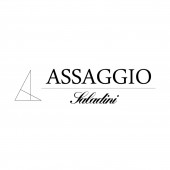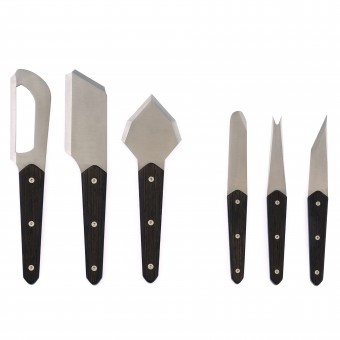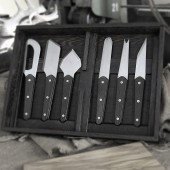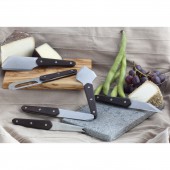DESIGN NAME:
Assaggio Cutlery Set
PRIMARY FUNCTION:
Cutlery Set For Cheese Tasting
INSPIRATION:
Innovation in tools for food is really hard since shapes of such things remained the same for ages (Pedretti, 2015). This feature is a focus point of this project. Indeed the shape of each blade is inspired by the cuts of the flints used by primitive men. The goal was to design eating tools that would communicate something in order to excite the user. In fact, the theme of the project is influence that the context within a meal is consumed has on it.
Pedretti, A., “Selezione naturale e artificiale”, in Celant, G., Arts&Food, riuali dal 1851, Mondadori Electa: Verona, 2015.
UNIQUE PROPERTIES / PROJECT DESCRIPTION:
This cutlery set for cheese differs from the others because it is focused on use experience. Moreover, it is centered on the user since it requires their attention to work. Indeed, the user is involved in the eating experience since they have to follow a tasting path which will lead to an increasing and complete perception of the same flavor. In fact, tasting the same cheese with a different tools will change the flavor tasted. This happens because shape of objects affects our perception of flavor as C. Spence demonstrated with his studies (2013).
Harrar, H., Spence, C., “The taste of cutlery”, Flavour, 2, 2013.
OPERATION / FLOW / INTERACTION:
The set consists of six blades: three for serving and three for tasting. The serving knives meet the cutting requirements for the most common cheeses. Indeed each blade has a double function developed observing the actions we usually do with different type of cheese paste. The tasting cutlery have been developed focusing on the idea that shape of objects has influence on our perception of flavour as the psychologist C. Spence demonstrated with his studies. The flavour of the same pice of cheese will increase by tasting it at first with the putty knife, then with the fork and at last with the pin blade.
PROJECT DURATION AND LOCATION:
I started to develop this project in November 2015 and finished it for my dissertation on April 2016. It was exhibited during Catanzaro Design Week in Septembe 2016.
FITS BEST INTO CATEGORY:
Food, Beverage and Culinary Arts Design
|
PRODUCTION / REALIZATION TECHNOLOGY:
The blades have been produced from cut high carbon steel sheet. The handle is made of wengè wood. Moreover, consumers buy culture, the culture that arises from a crafted object, which is manufactured in a specific territory and in a defined historical and social dimension (Micelli, 2011, p.54).
Micelli, S., Futuro artigiano, Venezia: Marsilio, 2011.
SPECIFICATIONS / TECHNICAL PROPERTIES:
Final Dimensions
Serving knives:
handle 12-20mm x 12mm x 100mm; blade 35-45mm x 1.5mm x 60-75mm
Tasting tools:
handle 10-16mm x 10mm x 80mm ; blade 2-15mmx 1.5mmx 70mm
TAGS:
Tableware, knives, cheese tasting, product design for food, food design, eating experience, cutlery, flavor perception,
RESEARCH ABSTRACT:
It is really important to be aware of the role of the senses in the flavor perception and how this one can be affected by table objects. Indeed, in this way we can be conscious about the complex act of eating. It is easier to pay attention to all this factors in a specific moment such as tasting experience, since we have different expectations than a daily meal.Is it possible to change the perception we have of a piece of food just with objects? Are all the people aware about the role of eating tools during the flavor perception? The project intends to define a new kind of tasting experience setting a different way of use since it requires the user's attention to work. In order to help people to become aware about the food they eat it is necessary to catch their attention through the objects used and the context within a meal is consumed (see Spence, 2014, p.290). From a ritual and central moment in the daily life, it became a distracted act. “Meal multi-tasking [...] is popular.” (Wasnik, 2006, p.70). With a Human-Centered- Design approach “need profiles”, “criticality in use”, “new scenario” were identified (Tosi, 2012).
Spence, C., e Betina Piqueras-Fiszman, The perfect meal: The multisensory science of food and dining, New York: John Wiley & Sons, 2014.
Tosi, F., “Ergonomia, Design, Design For All.”, in Steffan, I., Il Progetto per Tutti. Metodi, strumenti, applicazioni, Italia: Maggioli,2012.
Wansink, B., Mindless eating, New York: Bantam Books, 2006.
CHALLENGE:
The aim of the project was to help people to pay attention on what they perceive while eating. Initially I found difficult to explain my project because many people were hostile to believe that objects could influence our perceptions. In fact, this is the reason why I decided to address this design to tasters since they are aware of the importance of objects to appreciate food.
ADDED DATE:
2017-01-10 08:52:21
TEAM MEMBERS (1) :
IMAGE CREDITS:
Federica Di Pietro, 2016.
PATENTS/COPYRIGHTS:
Copyrights belong to Federica Di Pietro
|









